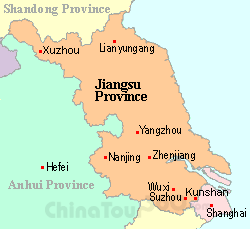 Facts
Facts
Phone Code: 025
Postal Code: 210000 - 213000
Area: 6,597 square kilometers (2,547 square miles)
Population: 8,109,100 (2011 statistics)
Neighboring Areas: Zhenjiang, Yangzhou, Changzhou, Chuzhou, Ma’anshan, and Xuanzhou cities
Location: Nanjing City lies southwest of Jiangsu Province, the fertile central areas of the lower reach of Yangtze River. Its longitude is between 118°22′and 119°14′E, and the latitude lies between 31°14′and 32°37′N.
Physical Features: Over 60 % of the city is covered by low hills and hillocks, and the rest are plains, lowland, rivers and lakes. Zhongshan Mountain lies east of the city, while the Yangtze River flows through the west of the city.

History: It is one of the most famous ancient cities in China. According to archeological discoveries, there were traces of human in Nanjing as early as 300,000 years ago, and primitive villages appeared about 6,000 years ago. In 472 BC, Gou Jian, the king of Yue Kingdom of the
Warring States Period (476 BC - 221 BC), established Yue City in the area. During the
Three Kingdoms Period (220 - 280), the Wu Kingdom moved the capital here and renamed it Jianye City. In the following 1,700 years, it was the capital of Eastern Jin Dynasty (317 - 420), Song, Qi, Liang, and Chen of the
Southern and Northern Dynasties (386 - 589), Southern Tang of the
Five Dynasties and Ten States (902 - 979),
Ming Dynasty (1368 - 1644), and finally, the Republic of China (1911 - 1949).

Recommended Tour Itinerary:
Shanghai Surrounding Tour: 6 Days of Hangzhou - Suzhou - Wuxi - Nanjing
 Attractions
Attractions: The city is famous for its long history and rich culture, and is regarded as one of the Four Great Ancient Capitals of China, along with
Beijing,
Xian, and
Luoyang. The Yangtze River also endows the city's charming scenery of waters.
Qinhuai River is considered as the “Mother River” of the city. The Qinhuai River Scenic Area also includes many famous constructions, such as
Confucius Temple, Zhanyuan Garden, Egret Islet Park, and the Gate of China.
Dr. Sun Yat-sen's Mausoleum was built to commemorate the founding father of the Republic of China and the pioneer of Chinese democratic revolution. To the west of the mausoleum lies the
Mingxiaoling Mausoleum, tomb of the first emperor of the Ming Dynasty Zhu Yuanzhang and his empress. It is one of the largest ancient imperial tombs in China.
Nanjing Yangtze River Bridge links the urban area and Pukou district. It is a double-decker bridge that can be used by both cars and trains.
More Attractions:
Purple Mountain Observatory and
Qixia Mountain.

Transportation

Air: Lukou International Airport is 35.8 km (23.9 miles) from downtown area. It operates international flights to Singapore, Seoul, Osaka, Bangkok, Frankfurt, Hong Kong, Macau, Los Angeles, London, Moscow, Vancouver, Kuala Lumpur, Phuket, and Sabah. Domestic flights are also available to most cities in China. Please refer to the
Nanjing Flight Schedule for details.

Train: Nanjing is an important railway terminal in China. Many trains linking Northern, Eastern, and Central China make the city a transit station. It is also an important station for the Beijing-Shanghai Express Train. The Intercity Express Train to Shanghai commenced operation, too. The city now has the following passenger stations: Nanjing Railway Station, Gate of China Railway Station, South Railway Station, Liuhe Railway Station, Jiangpu Railway Station, and Xianlin Railway Station. Please refer to
Nanjing Train Schedule for details

Bus: Visitor can reach the city by bus. It is currently an important stop for 5 national highways and 4 state roads. The four bus stations (Central Gate, North, East, and South Long-Distance Bus Stations) operate long-distance buses to most cities and towns in China. Hongqiao Bus Station operates the tourist buses.

Intercity Bus: There are over 300 intercity bus routes in the city, including 26 night lines, 6 tourist lines, and about 70 lines to suburban areas. The fare for a normal bus is CNY 1 and CNY 2 for an air-conditioning bus.

Subway: There are four subway lines in the city - Line 1 (Nanjing Olympic Sports Center - Mai Gao Bridge), Southern Extension of Line 1 (Ande Gate - China Pharmaceutical University), Line 2 (Youfang Bridge - Maqun), and Eastern Extension of Line 2 (Maquan - Jingtian Road). Now, Subway Line 3, Line 10, Line 4, Airport Line, and Line 12 are currently under construction. Line 11 construction will commence in 2012.

Ferry: Ferries are also an important mode of transportation in Nanjing. The ferry line linking Zhongshan Port and Pukou Port is the major path to cross the Yangtze River. Banqiao Car Ferry is an important mode for vehicles and motor-cyclists to cross the Yangtze River.
 Weather
Weather: The city has a subtropical humid climate with distinct four seasons and plentiful rainfall. The average temperature in January is 1.6°C (34.9°F), while that for July is 30.6°C (87.1°F). The rainy season comes mainly in June and July.

Dining and Shopping
Four most famous local cuisines are Sweet and Sour Fish, Steamed Dumplings with Egg Wrapper, Fried Duck Pancreas, and Phoenix Tail Prawns. The locals are very fond of ducks and geese dishes. Some of the best locations to enjoy local snacks are Confucius Temple, Lion Bridge (near Hunan Road), and Gan’s Garden, just to name a few.
Nanjing Brocade, Jiangning gold foil crafts, velvet, antique finished ivory carving, Jinling folding fans, and wooden carvings are the few famous local handicrafts.
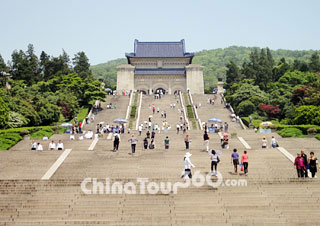 Dr. Sun Yat-sen's Mausoleum
Dr. Sun Yat-sen's Mausoleum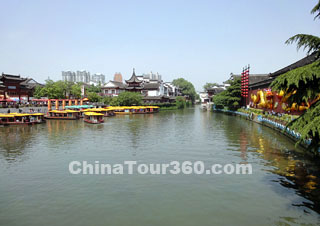 Confucius Temple
Confucius Temple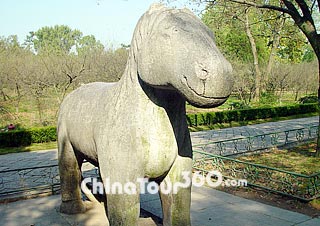 Mingxiaoling Mausoleum
Mingxiaoling Mausoleum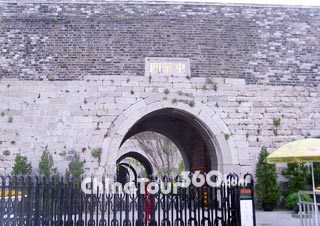 China Gate
China Gate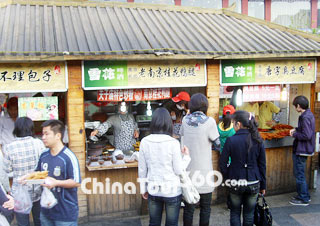 Local Snacks
Local Snacks![]() Facts
Facts 